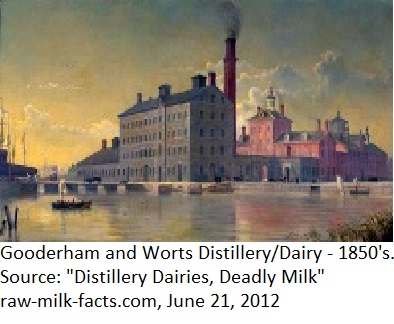Try to find good raw milk in preference to even low-heat pasteurized milk
in 1864, French
scientist Louis Pasteur invented a heat treatment process to kill microbes.
Pasteur discovered that microbes were responsible for souring wine and beer.

In the U.S., the early 19th century saw the growth of whiskey and other alcohol distilleries producing large amounts of spent-grains, called swill. To dispose of this by-product, many distilleries opened dairies and fed their cows with this low nutritional content, waste swill, leading to sickness in the cows and the humans who drank their milk.
"Confined to filthy, manure-filled pens, the unfortunate cows gave a pale, bluish milk so poor in quality, it couldn't even be used for making butter or cheese." Raw-milk-facts.com
Milk pasteurization was promoted in developed countries in the early 20th century. In the 1940's, the U'S government mandated that milk sold for human consumption must be pasteurized. However, individual states can adopt their own laws allowing the sale of raw milk and its products, but it can not be sold across state lines.
Milk from dairy farms is transported to processing plants to be pasteurized within a few days of milking. The purpose of pasteurization is to reduce/remove harmful bacterial presence. This prevents spoilage/extends shelf life and reduces bacterial contamination related to certain diseases, including tuberculosis, brucellosis, diptheria, typhoid fever, scarlet fever and food poisoning from pathogenic bacteria such as Salmonella, E. coli, Campylobacter and Listeria.
In the U.S., the standard high temperature/short time (HTST) pasteurization method heats milk to at least 161°F for 15 seconds or more. Milk is heated high enough and long enough to destroy a specific enzyme in the milk (phosphatase), at which point it is determined that many of the pathogenic bacteria are also dead.
Milk pasteurization was introduced into Western civilizations to reduce bacterial contamination of milk due to poor conditions in some farms and dairies. Instead of setting up a system to inspect the cleanliness of the production environment, it was decided that the milk should be sterilized.
Unfortunately, standard HTST and UHT pasteurization destroys enzymes, denatures proteins, kills beneficial bacteria, reduces some vitamins (viz: B2, B12, C and E) and inactivates immune factors that naturally protect the milk from spoilage
Effects of pasteurization on nutrients in milk
Pasteurization is unnecessary - with today's modern milking machines, temperature-controlled, stainless-steel holding tanks, efficient distribution, sanitary packaging and government inspected production, pasteurization is simply not necessary.